
Succeeding sweet potato cultivation for beautiful harvests
Contents
Sweet potato in a nutshell
- Sweet potato cultivation is entirely possible in France, provided that its requirements for water and heat are respected.
- This vegetable is mainly grown for its tubercles, but its leaves are also edible.
- It is easy to make your own sweet potato plants by propagation by cuttings at the beginning of the year to plant them after the frosts in May.
- It enjoys light, loose, well-drained soil that is rich in organic matter.
- Knowing when to harvest sweet potatoes allows for optimal production: do not harvest before the end of October or November.
A word from our expert
The sweet potato is a plant of tropical or subtropical origin, requiring warmth and water to thrive. Despite this somewhat demanding character, growing sweet potatoes in France is indeed possible, and has been since 1750. This long-cultivated plant does particularly well in the south, in open ground and outdoors, but can also be attempted in cooler regions: in this case, it is better to favour cultivation under cover or in pots.
It takes about 5 to 6 months from the planting of the sweet potato to the harvest of the sweet potato, or even longer if one chooses to produce their own plants by propagation by cuttings. It is indeed very simple to make your own sweet potato plants from a tubercle, a first step for those who want to know how to grow sweet potatoes. Be careful not to miss the planting season! When to plant sweet potatoes? Planting sweet potatoes is done outdoors between mid-May and June, when temperatures are warm enough to plant a sweet potato without the risk of frost.
The vegetable varieties of sweet potatoes produce elongated tubercles with flesh that can be white, yellow, orange, or purple. Among the most well-known, the variety ‘Evangeline’ stands out for its orange and very sweet flesh, while ‘Murasaki 29’ reveals a whiter flesh, less sweet than the former, but with a slight nutty flavour.
For a good harvest of sweet potatoes, it is essential to master the duration of cultivation and know when to harvest sweet potatoes: generally between October and November.
Plant it this spring to discover how to grow sweet potatoes and enjoy an excellent yield per sweet potato plant, even in France!
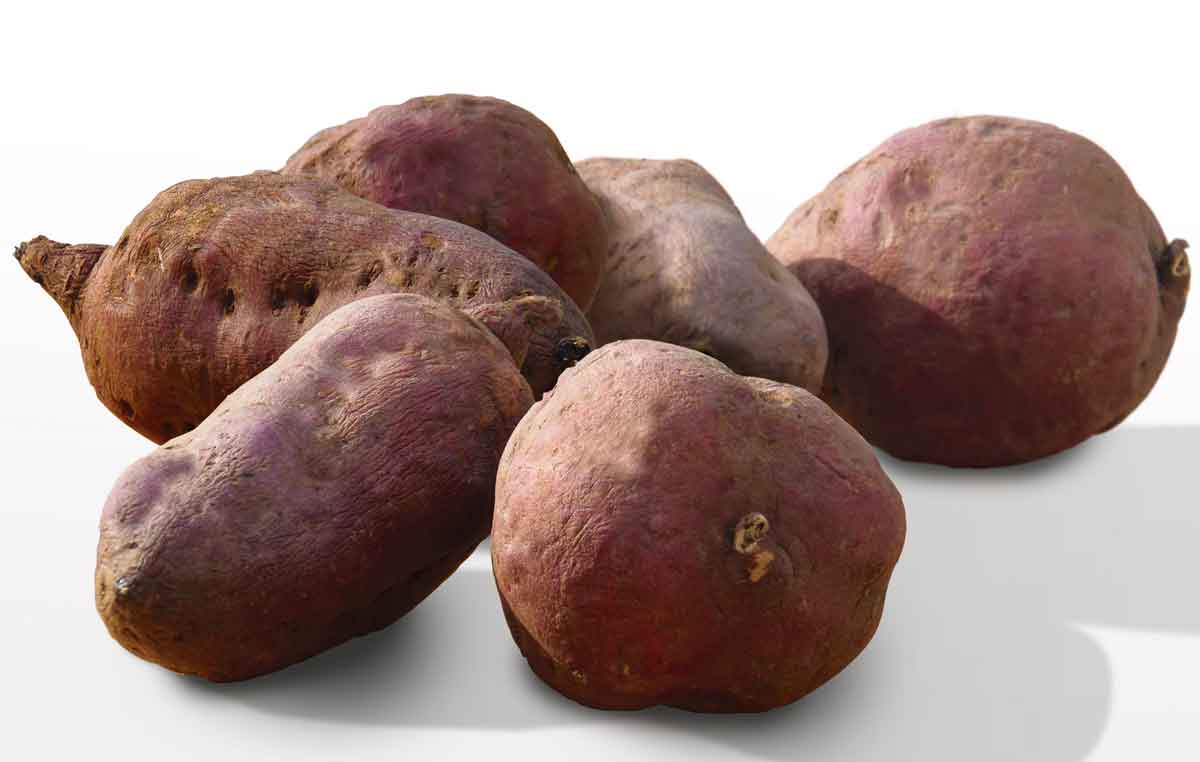
Description and Botany
Botanical data
- Latin name Ipomoea batatas
- Family Convolvulaceae
- Common name Sweet potato
- Flowering Annual
- Height NC
- Sun exposure Sun
- Soil type loose, light, well-drained and rich
- Hardiness Not hardy
Sweet potato is native to South America, and it was later cultivated in Polynesia and New Zealand before spreading to Southeast Asia. It was known in China around the 14th century, having arrived via the Philippines. Its current distribution corresponds to all tropical and subtropical areas, as well as the Mediterranean region. After the conquest of the Americas, its spread was accelerated worldwide by the Spanish and Portuguese.
Sweet potato, Ipomoea batatas, belongs to the Convolvulaceae family, alongside morning glories, bindweeds, and bindweed. It is cultivated for its elongated, rounded tubers, which have a sweet flavour and a floury texture. Reaching only about twenty centimetres in height, this voluble plant can spread several metres wide thanks to its long creeping stems.
Etymologically, the family name Convolvulaceae comes from the Latin convolvere, meaning “to coil”, aptly describing the twining nature of plants in this family. The genus name Ipomoea derives from the Greek ips meaning “worm” and homoios meaning “similar”, referring to a “worm-like plant”.
Sweet potato is a perennial plant with creeping stems bearing alternate leaves, with long petioles and a more or less dentate or lobed, cordiform lamina. The flowers have a fused corolla, and they are white or purple with a darker centre, pink or purple. It produces tubers that are more or less elongated or rounded, covered with a thin skin. The colour of this skin varies according to the varieties, generally red-orange or purple, yellow, or beige. The flesh is either orange or white.
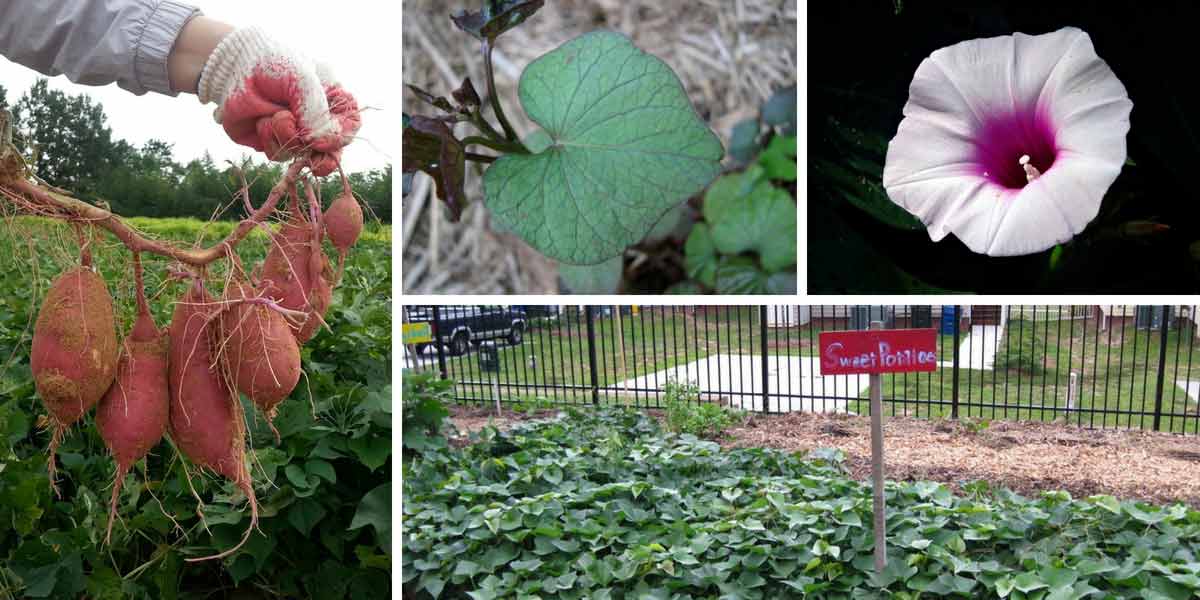
Tubers growing along the root – Cordiform leaf – Flower with fused corolla – Overall view of a sweet potato crop
Read also
Planting potatoSweet potato varieties
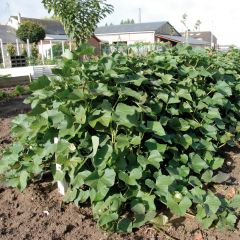
Sweet Potato Beauregard Plants - Ipomoea batatas
- Flowering time August to October
- Height at maturity 20 cm

Sweet Potato Bonita - Ipomoea batatas
- Flowering time August to October
- Height at maturity 20 cm

Ipomoea batatas 'Evangeline'
- Flowering time August to October
- Height at maturity 20 cm

Sweet Potato Murasaki 29 plants - Ipomoea batatas
- Flowering time August to October
- Height at maturity 20 cm

Sweet Potato Orleans plants - Ipomoea batatas
- Flowering time August to October
- Height at maturity 20 cm
Discover other Sweet potato plants
View all →Available in 1 sizes
Available in 1 sizes
Available in 0 sizes
Available in 2 sizes
Available in 2 sizes
Available in 1 sizes
Available in 1 sizes
Available in 1 sizes
Available in 1 sizes
Available in 1 sizes
Sweet potato planting
Where to plant sweet potatoes?
Growing sweet potatoes requires average temperatures above 20°C, ideally around 25°C. This is a vegetable that can be planted in open ground if summers are warm. For cooler regions, prefer growing them in a greenhouse or large pot and always choose a very sunny location.
When to plant sweet potatoes?
The planting of sweet potatoes in open ground can start in mid-May, when the risk of frost has passed and the soil is sufficiently warmed. It can continue until June.
How to plant sweet potatoes?
Growing sweet potato plants from plug plants
If you are starting your crop from plug plants and it is still too early to plant them outside, start by growing them on, transplanting them into buckets 8 to 13 cm in diameter, filled with potting soil. Place them in a warm, bright location and water regularly.
→ Learn more with our tutorial: Planting sweet potato plug plants
In open ground and under cover:
The planting distances are 90 cm between the rows and 30 cm within the row. To plant a sweet potato:
- Loosen the soil deeply.
- Mound the soil along the entire row to form a ridge 15 cm high.
- Flatten the top and plant the young plants.
- Hill up the plants when the stems are well developed.
- Water very regularly, as sweet potatoes need it to grow well.
Planting sweet potatoes in pots:
For pot planting, use pots of at least 30 cm in diameter, filled with a mix of potting soil and garden soil.
- Transplant the young plants into this mix without filling the pot completely.
- Water regularly without allowing the potting soil to dry out.
- Place the pots in full sun.
- Hill up the plants by adding potting soil as the plants grow.
This way, you will obtain a beautiful plant and a small harvest will be possible in autumn, although it will be less significant than in open ground.
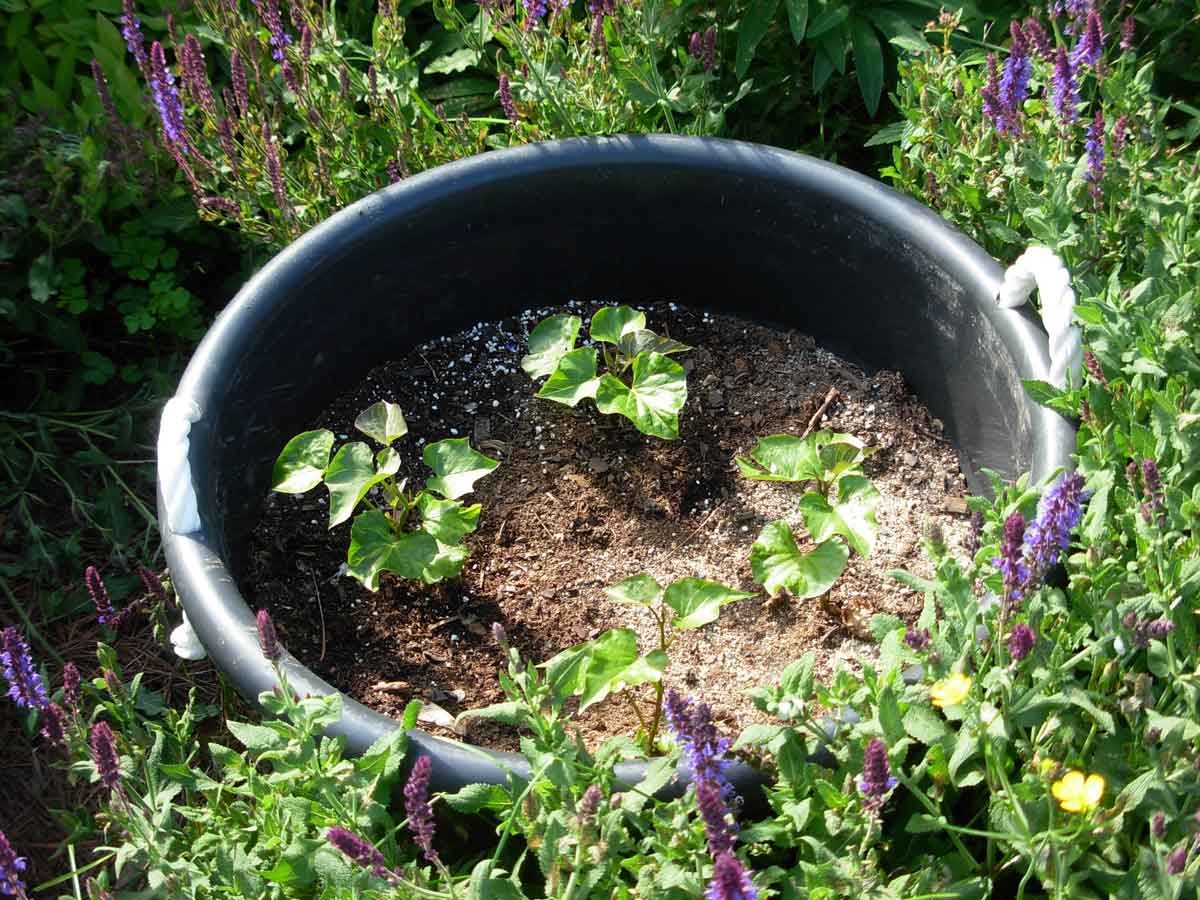
Cultivate in pots if your climate is not warm enough for its cultivation.
Sweet potato care
Sweet potato thrives in most types of soil, with a preference for loose, sandy, well-drained, and rich soils. Ideally, add compost in autumn for planting the following spring. Otherwise, add well-matured compost in spring at the time of planting.
Ensure a sufficiently large space, as sweet potato develops long creeping shoots. In fairly heavy soil, forming a mound for planting is recommended. This allows for good soil warming and the creation of a well-loosened growing area, facilitating the development of tubercles, as well as the future harvest of sweet potatoes. Tuberisation occurs at the end of the growing season, during decreasing days, after 15 August. Planting in May allows for early harvests in September, October, or even November.
Caring for sweet potato involves regularly watering during the recovery period and throughout the growing season. To know when to water, feel the soil; it should remain moist. As harvest approaches, reduce watering to avoid the risk of rot. At the beginning of the growing season, hoe and weed often afterwards, and mulch generously to retain good moisture in the soil and limit weeding. Using drip irrigation is ideal for managing watering effectively.
Common pests and diseases of sweet potatoes
Common pests
-
Flea beetles
These are small beetles that perforate the leaves, especially at the beginning of growth. They can slow down the development of young plants. -
Sweet potato weevil (Cylas formicarius)
This is one of the most destructive pests. It lays its eggs in the stems or tubercles. The larvae burrow galleries, making the roots unfit for consumption. -
Root-knot nematodes (Meloidogyne spp.)
These microscopic worms cause galls on the roots, reduce plant vigour, and can decrease yield. -
Aphids
They attack the leaves by sucking the sap. In addition to weakening the plants, they can transmit viruses.
Common diseases
-
Bacterial soft rot (Erwinia spp.)
This disease makes the tubercles soft, slimy, and foul-smelling. It often appears after injury or in cases of excessive moisture. -
Black rot (Ceratocystis fimbriata)
It causes black lesions on the roots and can spread rapidly if conditions are favourable. -
Powdery mildew
A fungus that appears as a white powder on the leaves. It is less common but can weaken the plant. Learn all about white disease or powdery mildew. -
Downy mildew
Rare on sweet potato, but possible in very humid conditions. It manifests as dark spots on the leaves.
Prevention and natural solutions
-
Crop rotation: it limits the pressure from soil pests and diseases.
-
Mulching: helps retain moisture and limit the spread of certain insects.
-
Companion plants : basil, garlic, or marigolds can repel certain insects.
-
Use of nets or traps: useful against flea beetles or weevils.
-
Good spacing and drainage: this helps avoid diseases caused by moisture.

Sweet potato multiplication
It is possible to make your own sweet potato plants from a simple tubercle. Choose one that is not too large so that it can fit into a glass jar.
How to sprout sweet potatoes?
- From February to March, place your tubercle half submerged in a glass of water. It can be held in place by toothpicks, just like sprouting avocado stones.
- Place it near a window or under artificial light (take the opportunity to sprout your tomatoes and other solanaceous plants!)
- In a few weeks, the shoots will develop, which will be propagated later.
Remember to change the water regularly to avoid any rot issues.
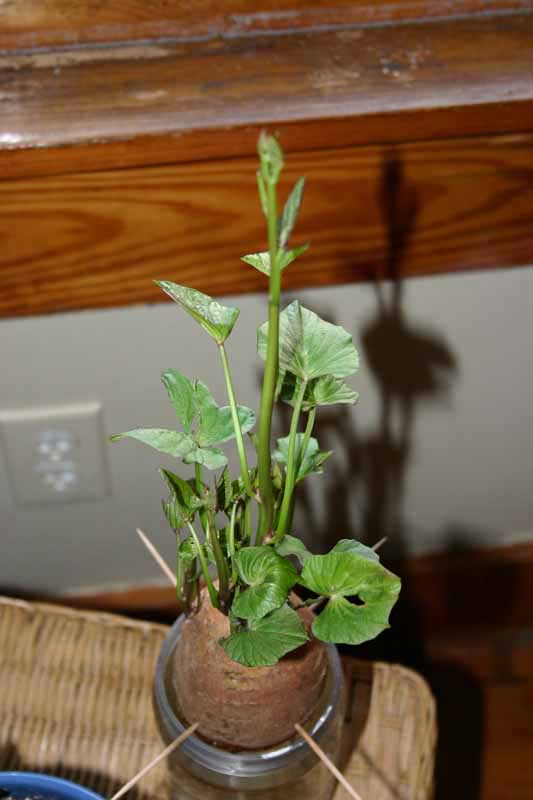
It is easy to make sweet potato shoots
Note: This fun technique is good for producing a few plants. To produce more, place several tubercles flat in a draining substrate (potting soil and sand), water, and let the shoots come up from each tubercle. Separate the shoots to obtain several plants from each tubercle.
→ Learn more with Sophie in the tutorial: How to sprout and propagate sweet potatoes?
How to make cuttings of sweet potatoes?
- Get a pair of clean scissors.
- Fill buckets or trays with potting soil for sowing and cuttings, and moisten it well, preferably by soaking.
- Take your sprouted tubercle and cut sections of stem with two or three leaves.
- Plant your sections in the moist potting soil.
- Place in the shade and keep the potting soil moist until the plants take root and develop.
- In May or June, your plants will be ready to be transplanted into the garden.
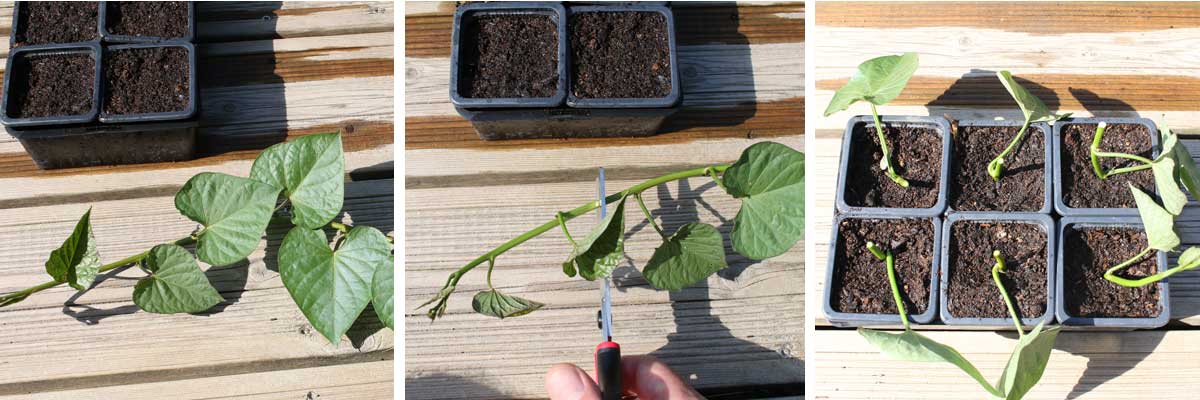
The steps for propagating sweet potatoes
Harvesting Sweet Potatoes and Storage
Sweet potato is a short-day plant, and tuberisation (the formation of edible tubercles) occurs from 15th August, peaking in October. Just before harvesting, cut the yellowing foliage. Gently lift the tubercles with a fork, taking care not to damage them. Leave them to dry in the sun for a few hours. The harvest should be completed before the first frosts. For an optimal sweet potato harvest, wait, if possible, until November to harvest them!
Wait about two weeks before consuming the tubercles after harvest, as the starch will convert into sugars. Sweet potatoes are stored like potatoes. Keep them in a cool, dry place away from light.
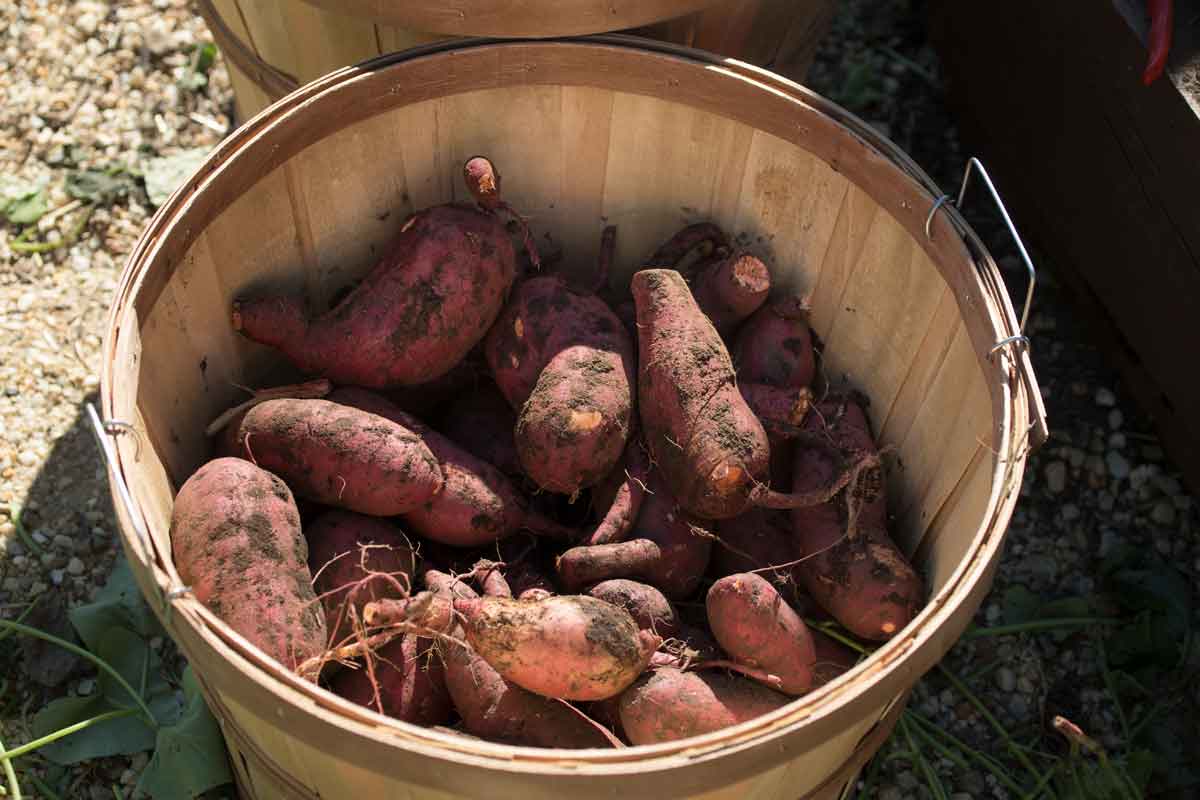
The long-awaited moment after several months of cultivation!
Useful resources
Discover in our online shop our range of sweet potato plants
Learn more about sweet potato in our series the travelling plants
Frequently asked questions
-
My sweet potato isn't sprouting to take cuttings.
It is the tip of the sweet potato that must be submerged so that the other end produces shoots. It must always be in contact with water.
-
Sweet potato, what yield per plant?
The yield of sweet potato varies depending on growing conditions (heat, watering) but also according to varieties ("Beauregard" is known for its productivity). However, you can typically expect a harvest of 6 to 8 tubercles per plant.
- Subscribe!
- Contents


































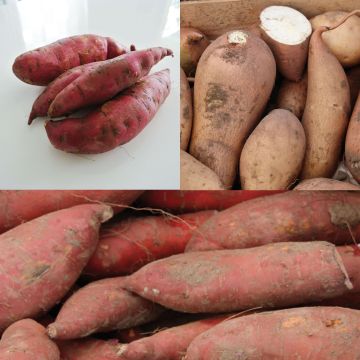


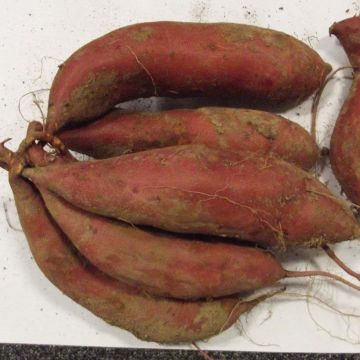
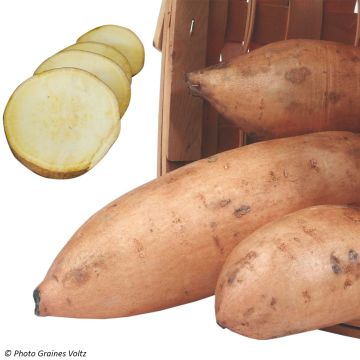
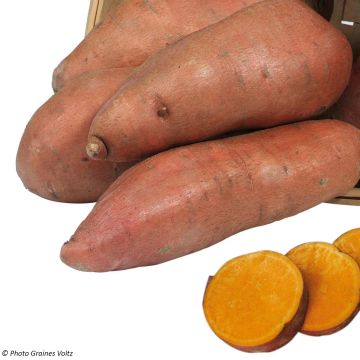


Comments